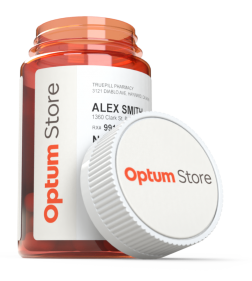
Is it safe to take OTC pain medication every day?

Before you pop off the cap, think about your health history and sticking to the right dose of an over-the-counter pain reliever.
Take a peek into anyone’s medicine cabinet and you’ll likely find a bottle or 2 of Tylenol® or Advil®. Over-the-counter (OTC) pain medication is a common go-to for treating everything from headaches and fever to joint pain and muscle aches.
And it's generally safe when taken at the recommended doses, says the American Academy of Family Physicians. The problem is that people often overdo it.
That’s especially the case for those living with chronic pain, according to a national survey by the American Gastroenterological Association. In fact, 43% of respondents with chronic pain said they’ve taken more than the recommended dose of an OTC pain medication.
But just because you don’t need a prescription for acetaminophen or non-steroidal anti-inflammatories (NSAIDs) such as ibuprofen or naproxen doesn’t mean they’re harmless. Taking too much, or for too long, can cause major health issues.
“At high enough doses, any medication can result in toxic side effects,” says Emily Leppien, PharmD. She is a clinical assistant professor in the School of Pharmacy and Pharmaceutical Sciences at Binghamton University in New York.
So how do you ease the pain and stay safe? Here’s a look at common OTC pain relievers, the risks they might pose and how to take them safely.
No matter what medications you rely on to manage pain, you can find a variety of options at our store—including everyday OTC necessities that are FSA-/HSA-eligible.
Acetaminophen
You’ll probably know this one best by its brand name, Tylenol®. It’s used by more than 60 million people every week to treat fever, headaches and arthritis pain, among other things, according to the National Institutes of Health. If you plan to take acetaminophen — or any pain reliever — most days of the week, talk to your doctor or pharmacist first.
The recommended dose is no more than 2 tablets (325 mg per tablet) every 4 to 6 hours, for a maximum of 4,000 mg a day. Don't take more than that — it can increase the risk of liver damage. That’s especially true for people with current or past liver disease or who drink more than 3 alcoholic beverages a day.
If you’re taking acetaminophen, check the labels of any other medications you take. More than 600 OTC and prescription medications contain acetaminophen, according to the Food and Drug Administration. It's commonly included with oxycodone, as well as popular OTC allergy and cold and flu medications.
How to stay safe: Never take more than the recommended dose of acetaminophen. Make sure to read the labels of any medication you’re taking to look for acetaminophen. On prescription labels, it can sometimes appear as paracetamol or “APAP.” If you’re taking acetaminophen from multiple medications, do not exceed more than 4,000 mg from all sources.
Non-steroidal anti-inflammatory medications (NSAIDs)
Like acetaminophen, NSAIDs are mainly used to relieve pain and reduce fever. These include aspirin, naproxen (Aleve®) and ibuprofen (Advil®). Plus, they have an extra benefit: They can reduce inflammation and swelling. So they’re often taken to manage arthritis pain or muscle soreness.
It’s fine to take an OTC NSAID for occasional pain. But NSAIDs aren’t usually a good long-term option. In general, take them for no longer than 10 days in a row. And avoid taking them for more than 3 days in a row if you have a fever, says the Cleveland Clinic. Common side effects from NSAIDs can include upset stomach, lower leg swelling and increased blood pressure, Leppien says.
One big risk of prolonged NSAID use: potential stomach ulcers and bleeding, she adds. If that happens, you might have dark, bloody stool or bloody vomit that looks like coffee grounds. The risk of developing ulcers or bleeding is higher for people who:
- Take NSAIDs often
- Are age 65 and older
- Have a history of stomach ulcers
- Take blood thinners
- Take corticosteroids
A low dose (100 mg) of daily aspirin may help prevent blood clots, says Johns Hopkins Medicine. But that applies only to people with a history of heart disease or stroke. So talk to your doctor before creating a daily regimen.
How to stay safe: If you don’t have certain risk factors such as a history of heart disease, kidney damage or stomach ulcers, it’s generally safe to take the recommended dose of an NSAID as needed. “But avoid using an OTC NSAID for longer than 10 days without first checking with your health care provider to confirm it’s safe,” Leppien says. You also shouldn’t take 2 NSAID medications at the same time, she adds.
When a prescription medication might make sense
The rise in opioid dependency is alarming. And this can make OTC medications seem like a less risky way to manage your pain. But that doesn’t mean they’re always a better option. If you’re taking a higher-than-recommended dose just to get relief, your OTC pain relievers may not be up to the job. And both acetaminophen and NSAIDs have a limit on how much pain they can take away, no matter the dose. It’s important to not exceed the maximum dose written on the medication label in order to prevent side effects.
Talk to your doctor about other pain-relief treatments or prescription medications. Opioids are not your only option. For example, some people get relief from migraines by taking triptans. This type of medication restricts the arterial vessels in the brain that can dilate during a migraine. And some people with fibromyalgia can find relief by taking other medications such as antidepressants.
While these medications can have side effects, your doctor will know how much you’re taking and exactly what you’re taking. And this will make it easier to manage the risks.

Additional sources
OTC pain reliever background: MedlinePlus
Acetaminophen background: Harvard Medical School
60 million people use acetaminophen weekly: National Institutes of Health
NSAID background: Cleveland Clinic
Use of OTC pain medication and chronic pain survey: American Gastroenterological Association
What to consider when taking OTC pain medication: American Academy of Family Physicians